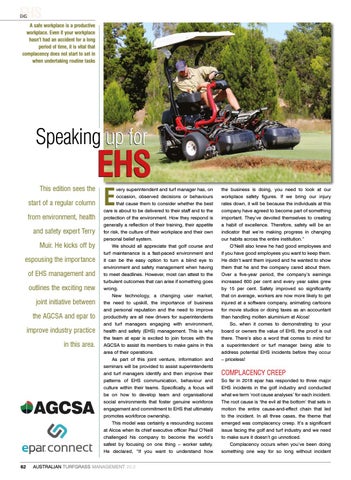EHS EHS
A safe workplace is a productive workplace. Even if your workplace hasn’t had an accident for a long period of time, it is vital that complacency does not start to set in when undertaking routine tasks
Speaking Standing up for This edition sees the start of a regular column from environment, health and safety expert Terry Muir. He kicks off by espousing the importance of EHS management and outlines the exciting new joint initiative between the AGCSA and epar to improve industry practice in this area.
62
EHS E
very superintendent and turf manager has, on occasion, observed decisions or behaviours that cause them to consider whether the best care is about to be delivered to their staff and to the protection of the environment. How they respond is generally a reflection of their training, their appetite for risk, the culture of their workplace and their own personal belief system. We should all appreciate that golf course and turf maintenance is a fast-paced environment and it can be the easy option to turn a blind eye to environment and safety management when having to meet deadlines. However, most can attest to the turbulent outcomes that can arise if something goes wrong. New technology, a changing user market, the need to upskill, the importance of business and personal reputation and the need to improve productivity are all new drivers for superintendents and turf managers engaging with environment, health and safety (EHS) management. This is why the team at epar is excited to join forces with the AGCSA to assist its members to make gains in this area of their operations. As part of this joint venture, information and seminars will be provided to assist superintendents and turf managers identify and then improve their patterns of EHS communication, behaviour and culture within their teams. Specifically, a focus will be on how to develop team and organisational social environments that foster genuine workforce engagement and commitment to EHS that ultimately promotes workforce ownership. This model was certainly a resounding success at Alcoa when its chief executive officer Paul O’Neill challenged his company to become the world’s safest by focusing on one thing – worker safety. He declared, “If you want to understand how
AUSTRALIAN TURFGRASS MANAGEMENT 20.3
the business is doing, you need to look at our workplace safety figures. If we bring our injury rates down, it will be because the individuals at this company have agreed to become part of something important. They’ve devoted themselves to creating a habit of excellence. Therefore, safety will be an indicator that we’re making progress in changing our habits across the entire institution.” O’Neill also knew he had good employees and if you have good employees you want to keep them. He didn’t want them injured and he wanted to show them that he and the company cared about them. Over a five-year period, the company’s earnings increased 600 per cent and every year sales grew by 15 per cent. Safety improved so significantly that on average, workers are now more likely to get injured at a software company, animating cartoons for movie studios or doing taxes as an accountant than handling molten aluminium at Alcoa! So, when it comes to demonstrating to your board or owners the value of EHS, the proof is out there. There’s also a word that comes to mind for a superintendent or turf manager being able to address potential EHS incidents before they occur – priceless!
COMPLACENCY CREEP So far in 2018 epar has responded to three major EHS incidents in the golf industry and conducted what we term ‘root cause analyses’ for each incident. The root cause is ‘the evil at the bottom’ that sets in motion the entire cause-and-effect chain that led to the incident. In all three cases, the theme that emerged was complacency creep. It’s a significant issue facing the golf and turf industry and we need to make sure it doesn’t go unnoticed. Complacency occurs when you’ve been doing something one way for so long without incident
